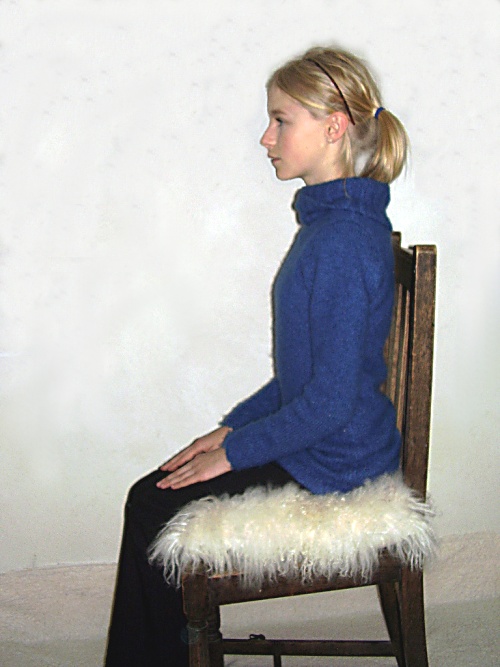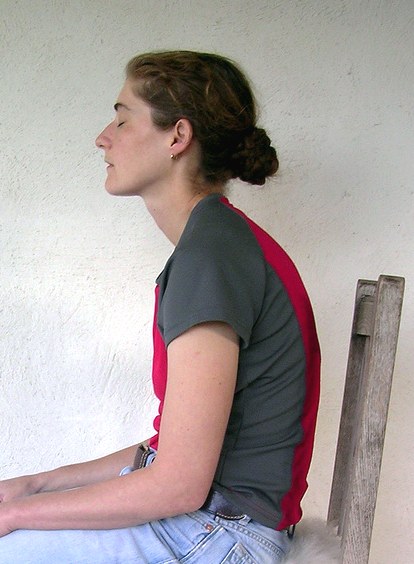
|

|
| resources | free course | mentoring | audio | FAQ | books | pictures | about Aro... |
| How to sit like a human |
How to sit like a humanThe figures on this page illustrate Week 3 of our free internet meditation course.
Figure 1 is a simplified image of the spine when sitting naturally. When the pelvis is higher than the knees, so that the thighs slope slightly downward, no muscular effort is required to balance the back of the head over the tailbone. The spine naturally has a slight S-shape. Figure 2 shows the spine when sitting on an upward-sloping (or too-low) seat. This is the most common way to sit in the West – where chairs are apparently designed to suit space aliens. The base of the spine forms the same angle with the pelvis as in Figure 1, so it slants backward in the lower back. In order to bring the head above the pelvis, one must contract the chest muscles (shown as arrows). This compresses the spine, forcing the vertebrae closer together. This position typically produces pain in the upper back, shoulders, and neck. Figure 3 shows the muscles of the lower back tensed in order to correct the forward angle of the spine as it rises from the pelvis. This can often be a problem when sitting on the floor on a meditation support that is too thick – or less commonly when sitting on a chair that is too high. It causes pain in the lower back. The problem also arises when you instinctively try to correct the problem of Figure 2 by tilting your pelvis forward. Then you wind up compressing the spine at both ends. That produces an exaggerated S-shape and is thoroughly uncomfortable. 
Figure 4: Sitting naturally in a chair. She has placed firm padding on the chair’s seat to raise it enough that her thighs slant slightly downward. Her back is not supported by the back of the chair—although that is difficult to see in this photograph. The highest point on her head—near the back—is directly above her ear, her shoulder joint, and the ‘sit bones’ near the back of her pelvis—where it rests on the seat. The back of her neck is relaxed – and elongated as a result. Her upper arms fall vertically from her shoulders – so that their weight does not pull her forward or back, nor does she need to use muscular effort to hold them in place. Her hands rest lightly on her thighs. Her lips are slightly parted. 
Figure 5: Slumping in a chair. This may result from a chair that is too low – but often it is simply habitual. Her pelvis tilts backward (see the angle of her belt). That forces her lower back to slant backward. To compensate, she has contracted the muscles in her chest – so that her upper back curves forward. To compensate for that she must contract the muscles in the back of her neck, so that it is tightly concave. Her ears are forward of her shoulders and well forward from the ‘sit’ bones in her pelvis. No wonder her expression is grim. 
Figure 6. The seat is too high – so her thighs slope sharply downward. That tilts her pelvis forward. To compensate, she has contracted the muscles in her lower back – making it sharply concave. |
|||||||
| Next > |
|---|